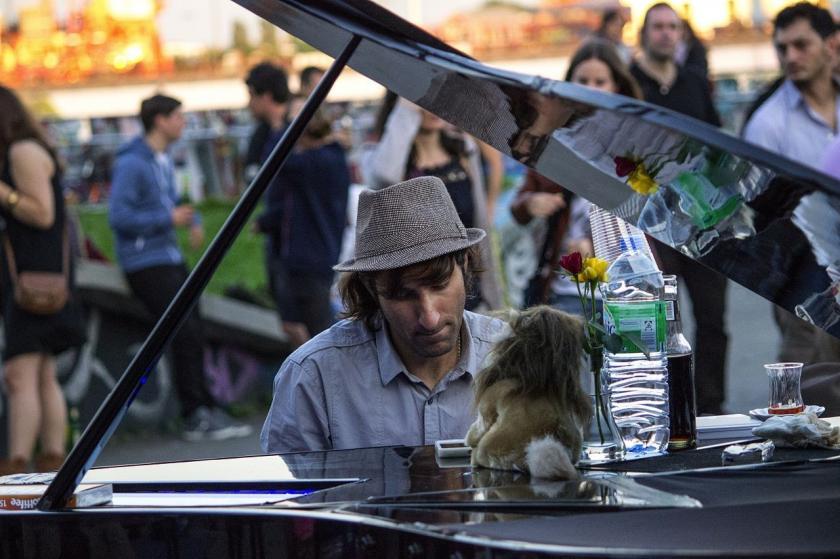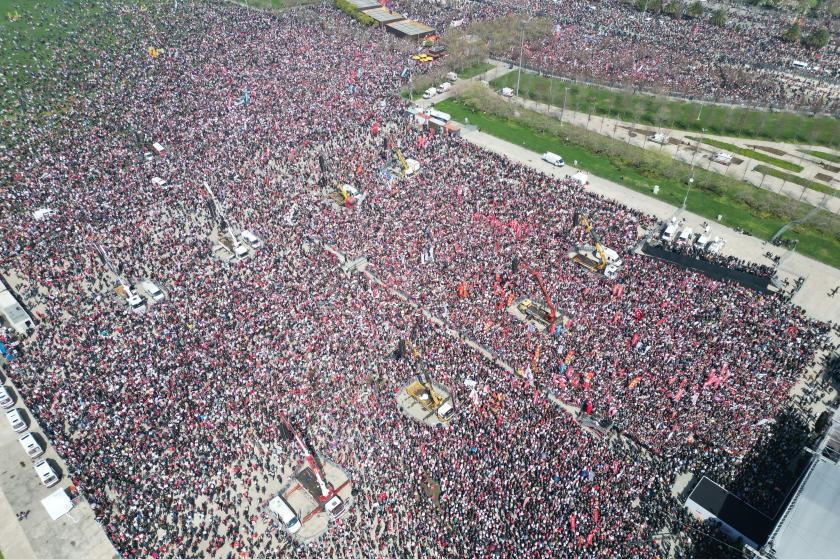2025 March protests: Bases, objectives and problems

A. Cihan Soylu

Fotoğraf:Evrensel
The 19 March protests, which started on 19 March and continued until the "eve of the holiday" and showed the potential to continue with student boycotts in the universities, took place in a period in which the reactions to the economic, social and political oppressions and attacks in different forms were seen in a fragmented and divided way. When these protests, with their massiveness, their insistence on continuity and their potential, became widespread, especially in the biggest cities of the country such as Istanbul, Ankara and Izmir, the ruling front intensified its policy of suppression and neutralisation and tried to limit its sphere of influence with a smear communication campaign that surpassed the Goebbelsian black propaganda, while the CHP administration turned towards a line calling for mass protests, an attitude that it had avoided until then. This is what happened.
For years, the opinion has been expressed in the newspaper columns that the palace government under the leadership of Erdoğan - also called the one-man rule - would intensify the repression and attacks against the reactions of the working class and all other labouring sections and the opposition of the organised progressive-revolutionary forces. The main characteristic of the opposition of the CHP leadership against the attacks, repressions and bans for years has been to present elections and the ballot box as the only alternative in addition to verbal criticism. This attitude and policy has been criticised for years by the revolutionary democrats and socialists as conciliatory and it has been stated that it would be in the interest of all the exploited and oppressed if the masses of the people who support the CHP would move away from this conciliatory and ineffective attitude in the face of the attacks and turn to transforming the workplaces, factories, schools, neighbourhoods and streets into areas of struggle. Apart from the "March for Justice", which was one of the most massive events of the CHP government in recent years, the protests of March 2025, which mobilised hundreds of thousands of people from different social segments (university and high school youth, unemployed youth, pensioners, retirees, neighbourhood labourers, municipal labourers, workers, in order of intensity) with different demands, were an indicator of an attitude and policy that the CHP under Özgür Özel had been holding back until then.
The truth is that neither the CHP leadership nor the Erdoğan government expected the widespread protests with such a large mass participation and with the support of the younger generations who are in favour of its continuous continuation. The well-paid elements of the communication-politics-military-intelligence network of Erdoğan and the palace administration expected that the job would be done with the kind of "harsh statements" that were made against them on the basis of the previous attacks and with veiled "threats" such as standing guard at the community centres, showing red cards, "Look, we are the first party, act accordingly! The CHP administration, on the other hand, did not expect that the policy of repression and intimidation against their party would extend to the arrest of more mayors, including İmamoğlu, as well as attempts to appoint 'trustees' to the party. However, the opposite of these two things happened. On the one hand, it was expected that the line of reconciliation would be followed, that the 'Turkish century' would be consecrated together and that the masses would be lulled to sleep with the rhetoric about it. This did not happen; it did not happen because the Erdoğan government was even inclined to "take" the CHP from the CHP government. Compromise softening did not work. Erdoğan even said something like 'it seems that we will form the opposition'. In order to stay in power, it was necessary to keep the CHP, the main party of the bourgeois opposition, in a controlled, limited and "constructive" opposition line. After all, Erdoğan and the AKP, as Arınç once said, 'did not come to power to leave'! The goal was continuity. It was the practice of power to stay in power until the "Order of Right!" is realised, that is, until death, to create a political Islamist-Turkish nationalist society through reactionary education and impositions from "cradle to grave" and to impose Necip Fazıl's understanding that all means are permissible for the vengeful and bigoted reactionary generations to plunder the country. The Erdoğan government has reconstructed and restructured institutions such as the army, the police, the MIT, the judiciary, the executive, the education system and the distribution of capital in its own favour. It is clearly different from all previous periods.
The policy of the bourgeois governments to maintain the support of the masses and to neutralise the opposition movements through the production of consent is well known. However, under the current international and national conditions, this government is not in a position to make concessions. Compromise because more effective struggles can pave the way for further compromises. They had declared that they are not bound by the bourgeois laws and the constitution, including the ones they made themselves. During the protests in March 2025, it was shown once again that the judiciary, legislature and executive of the "one-man rule" are united under the rule of an extremely narrow central oligarchic structure unified by palace decrees. Attack, detention, torture and arrest; it was an administrative practice that was obliged and doomed to more, not less. What is wanted is to bow down, not to make a sound. The dismissal of the mayors and their imprisonment in dungeons is a sign that the electoral and ballot box methods will be considered invalid if they produce results against the government. This is not a new situation. One of the most reactionary administrations in the history of monopoly capital, with the rhetoric of its spokesmen and practitioners, almost says: "You can only take power if you come with a stronger popular mobilisation and submission that will defeat us!
Although the March protests started with the calls of E. Although the March protests started with the calls of the Özgür Özel government against the cancellation of E. İmamoğlu's diploma and his imprisonment after being accused of corruption, unemployment, poverty, high inflation and continuing high prices, the intensification of political repression, the continuous expansion of the borders of bans, the continuous undermining of initiatives in the field of speech, press, publishing and organising in favour of the exploited and oppressed, the continuous regulations towards the barrack-like management of universities and the religiousisation of the education system ensured that this call found mass support. The investigations, 'secret witnesses', incriminating propaganda, police attacks and mass arrests, which were launched to achieve through the judicial mechanism what could not be achieved through the electoral mechanism, led to further reactions. However, the CHP leadership was faced with the problem of how far it could sustain the mass protests in the face of the ruling party's conviction not to make any concessions. The CHP was faced with a de facto situation and "responsibility" that it was not prepared for, did not expect and did not correspond to its general line. The relationship between the international and regional developments and the events and forces in the country only allowed the protests to continue for a certain period of time. Although the struggle within the ranks of the working class, especially in small and unorganised workplaces, over the problems of wages, working conditions and trade union organisation tended to grow, the influence of a very strong habit and approach to social life, such as trade union and political legitimacy, worked in the opposite direction. The largest trade union confederations were in favour of monopoly one-man power. The revolutionary organisations and the socialist party were not able to coordinate a resistance in the sense of a mass opposition.
The nine-day holiday - regardless of how effective the ruling party's political tactics were - once again offered a de facto 'solution opportunity' to the parties facing a stalemate. The CHP's 'Freedom for İmamoğlu rally' in Maltepe was a step in this direction. The mass and widespread continuation of the protests - if we can call it that - is now in a kind of intermediate state and at a distance for the time being. This is not an unexpected situation. In order for the organised united struggle, which some call social opposition and some see as having the potential of an uprising, to be more effective, the efforts to overcome the weaknesses and shortcomings mentioned above, as well as the situations of division, need to be more reciprocated. The working class and other labourers have to draw conclusions from the experiences of their own movement and the struggles of the previous generations, from the 15-16 June resistance to the protests of 1989, from the General Action of 1990 to the Zonguldak resistance, from the protests of 95-96 to the Great June Resistance of 2013. Those who compare the 2025 March protests with its predecessors, especially the "Gezi Resistance", and describe it as the biggest and most advanced action in the history of the Republic, either do not see or do not understand the characteristics of the movement, the demands of the participating masses, the policy of the leading party and the goal it shows. Some of those who evaluated the 2025 March protests also showed an understanding that blurred the difference between their own expectations about the goal of these protests and the opposition centred on "İmamoğlu's Right". However, there is no harm in a bourgeois democrat talking about "crowning the republic with democracy". Although bourgeois democracy has been formalised during the period of monopoly rule and great steps have been taken to intensify reaction in almost all countries in the current period, the working people will also benefit from the success of the struggle for the implementation of political democratic freedoms. However, the main difference between a Marxist and a bourgeois democrat in this field is the ability to show the exploited class and the oppressed how and where the link lies between overcoming the chain of oppression, prohibition and attack and liberation from exploitation.
The mass demonstrations continued for more than a week despite the attacks and developed in an unyielding line. It was possible to have a more massive, more organised, more effective and result-oriented demonstration with the power to repel the forces of power. This was the victory. It showed that.




Follow Evrensel